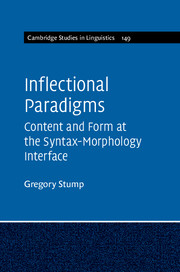Book contents
- Frontmatter
- Dedication
- Contents
- List of figures
- List of tables
- Acknowledgements
- List of abbreviations
- List of symbols and operators
- Introduction
- 1 What are inflectional paradigms?
- 2 Canonical inflectional paradigms
- 3 Morphosyntactic properties
- 4 Lexemes
- 5 Stems
- 6 Inflection classes
- 7 A conception of the relation of content to form in inflectional paradigms
- 8 Morphomic properties
- 9 Too many cells, too few cells
- 10 Syncretism
- 11 Suppletion and heteroclisis
- 12 Deponency and metaconjugation
- 13 Polyfunctionality
- 14 A theoretical synopsis and two further issues
- References
- Index
Introduction
Published online by Cambridge University Press: 18 December 2015
- Frontmatter
- Dedication
- Contents
- List of figures
- List of tables
- Acknowledgements
- List of abbreviations
- List of symbols and operators
- Introduction
- 1 What are inflectional paradigms?
- 2 Canonical inflectional paradigms
- 3 Morphosyntactic properties
- 4 Lexemes
- 5 Stems
- 6 Inflection classes
- 7 A conception of the relation of content to form in inflectional paradigms
- 8 Morphomic properties
- 9 Too many cells, too few cells
- 10 Syncretism
- 11 Suppletion and heteroclisis
- 12 Deponency and metaconjugation
- 13 Polyfunctionality
- 14 A theoretical synopsis and two further issues
- References
- Index
Summary
In recent years, a growing number of linguists have arrived at the conviction that inflectional paradigms play an essential role in the definition of a language's grammar and lexicon. Research on the properties and significance of inflectional paradigms is now being conducted in many subdisciplines of linguistics, including grammatical theory (e.g. Stump 2001, Blevins 2006, Ackerman, Blevins and Malouf 2009, O'Neill 2014, Round 2013 and the contributions to Plank 1990), language typology (Carstairs 1987, Baerman et al. 2005, 2007, 2010, Chumakina and Corbett 2013, Stump and Finkel 2013), historical linguistics (Fuß 2005, Maiden et al. 2011, Cruschina et al. 2013, Gardani 2013, Fertig 2013), psycholinguistics (Baayen and Schreuder 2003, Bittner et al. 2003, Milin et al. 2009) and computational linguistics (Beesley and Karttunen 2003, Brown and Hippisley 2012).
My purpose here is to examine the theoretical indispensability of inflectional paradigms, and in particular, their role as a grammatical interface. Thus, at the most general level, I am concerned with asserting two hypotheses about inflectional paradigms: (i) the irreducibility hypothesis, according to which some morphological regularities are, irreducibly, regularities in paradigm structure; and (ii) the interface hypothesis, according to which a language's paradigms are the interface of its inflectional morphology with its syntax and semantics. At a more concrete level, I will propose and justify a formal theory of inflectional morphology that is compatible with the irreducibility and interface hypotheses. This theory, the paradigm-linkage theory, was first proposed by Stump 2002, and was subsequently elaborated on by Ackerman and Stump 2004, Ackerman, Stump and Webelhuth 2011, Spencer and Stump 2013, Stewart and Stump 2007, Stump 2006, 2010, 2012, 2014a, 2015, Stump: to appear a, Stump: to appear b. O'Neill 2011, 2013 and Round 2013 have also advanced proposals that are closely akin to the paradigm-linkage theory, and the analysis of Nepali verb inflection proposed by Bonami and Boyé (2008, 2010) has important similarities as well.
The gist of the paradigm-linkage theory is that the definition of a language's inflectional morphology is based on three interlocking kinds of paradigms.
Information
- Type
- Chapter
- Information
- Inflectional ParadigmsContent and Form at the Syntax-Morphology Interface, pp. 1 - 7Publisher: Cambridge University PressPrint publication year: 2015
